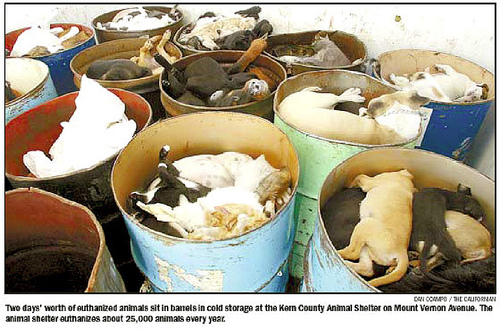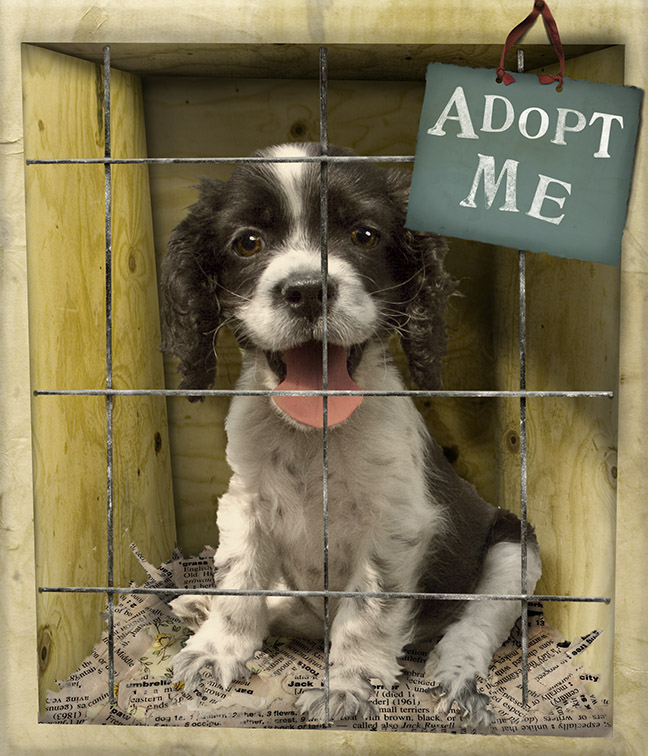Let's face it ... my staff and I undertook a huge challenge when we decided to create a place where unwanted pets would have a chance not just of survival, but of actually being well-cared for, loved, fed regularly, and kept in clean, safe surroundings until someone adopted them and took them to a loving home. But it was important to us, and it must be to you, too, or you wouldn't be taking the time to browse our website. So bear with me ... this is a topic near and dear to my heart, and after more than 20 years in the veterinary practice, I have a lot to say. Thanks for stopping by, and thank you from me and my staff for being such loyal and ardent supporters of our no-kill shelter! -- Dr. Roger Ross
Challenge Number One:
Finding and Keeping People Willing to Clean Up After Pets
This is the part where reality comes face to face with all the people I meet who seem to think that it would be easy for a veterinary clinic to take care of a stray pet...hardly any additional trouble or expense at all.
And that's true if you're talking about just one or two pets at a time. But once you start talking about 20-30 pets at a time like we have at our shelter, the reality is that you need to pay people to spend at least 2-3 hours in the morning and again in the evening to walk the dogs, clean out the runs and cages, clean the food dishes, change litter, and to give each of the pets a rub down and a hug.
And you can't just put 30 pets in a fenced in yard either...you have to have sturdy runs that are designed to take a lot of abuse and are easy to keep sanitary. You need a huge septic tank. You need heating and air conditioning and ventilation.
Volunteers occasionally help, and that's great, but when taking care of pets, like children, you can't rely on once-in-a-while help...it takes several hours twice a day, every week day, every weekend, every holiday.
Finding, keeping and organizing minimum wage workers willing to clean up after dogs and cats is no easy feat...our present corps of 20 young animal loving people who rotate these duties alongside their more interesting veterinary assistant duties are great...but we've had to hire 10 people for every one person that was worth keeping.
Why? If you've ever worked with the minimum wage crowd, you would understand; but allow me to make these generalizations:
In general, people willing to clean up after pets for low wages are usually very nice and likeable. Bad attitudes are not generally a problem.
Honest and trustworthy? Stealing, carelessness about doing a good job, carelessness about the equipment & facilities, and dishonesty by claiming jobs have been done when they haven't, as well as frequent poor judgment are MAJOR problems with a percentage of employees at all pay levels in business. Discovering and weeding out such employees is very stressful. On the other hand, our remaining staff seems to be exceptionally honest. I'm proud to be associated with them.
Reliable? Here's the big problem. There are lots of reasons people do non-glamorous work for low pay...many of them legitimate, but the reason a huge percentage of minimum wage workers are not able to get or keep higher level jobs is because, for any number of reasons (for instance, addictions, poor self discipline, lack of focus, and multiple personal problems) they don't seem capable of showing up regularly ... dressed, clean, sober, and ready to do a consistently good job. To put it more bluntly: finding and keeping decent, reliable people from among the minimum wage crowd is hard.
I mention all of this because non-business people seem to think, "Hey, cleaning up after dogs is an easy job...just hire a couple of high school kids."
Do you have any idea how unmotivated most American high school kids are? Or, I should say, unmotivated about the kind of work we need to have done every day. Even the "nice kids" give a very low priority to such jobs. School itself, vacations, hanging out, staying up late, sports, music, and a myriad of other commitments take priority.
College kids? They have even more numerous priorities. We have a great and fairly reliable group of pre-vet students helping us...BUT...they are only able to work certain days and have frequent scheduling problems so we need to have a bunch of them for every work slot in hopes that one will be free for the needed time. Recruiting, training, and scheduling these people takes a lot of work and time by our manager...who is definitely not a minimum wage worker.
Unskilled workers? Part time housewives looking for a little extra spending money and something to do? Desperate single moms? Moms who want something to do for short periods while their children are in school? Even when you can find decent people from the above categories willing to clean up after pets for low wages, they have complicated schedules, tend not to stay long (high turn over) and need lots of supervision and initial training.
Maintaining a good work crew is a big job in itself. Everyone you hire is a big risk: Will they get hurt on the job? Will they let an animal escape? Will they steal or sabotage? Do they spend more time talking on their cell phones, making excuses, having nervous breakdowns, and dealing with their personal problems than they do getting their chores done? I'm not whining...just trying to convey the problems of running a shelter.
Challenge Number Two:
The Type of Animals Surrendered to Shelters
Another reality is that the types of animals that end up in shelters are often there because, for whatever reason, they were unacceptable pets: This often means extremely "high strung" or destructive. It also often means poorly trained, unruly, unwilling to stay close by without a strong leash, and sometimes aggressive.
The pet is poorly house trained, or marks everywhere with stool or urine, or doesn't use a litter box. This often means that the pet has poor digestion leading to frequent upchucking and diarrhea, or has "sensitive skin" leading to odors, flaking, shedding , and an icky coat.
Often, surrendered or stray animals have unpleasant habits or health problems.
All that being said, there are also the sad cases where a pet's owner became ill or died, and there are no relatives available to keep the pet. These poor animals end up confused, sad and displaced ... through no fault of their own.
Now, we've taken these animals and placed them in a shelter, which no matter how clean or filled with friendly, caring staff, is still a very strange and stressful place for an animal ... and when pets are under stress, they are prone to diarrhea, upper respiratory infections, extreme behavior, self destructive behaviors, and illness.
Caring and rehabilitating such pets is not like taking care of your average sweet house pet.
After proof reading what I just wrote, I can see that the reader might conclude never to adopt a shelter pet. Luckily, most of the pets, with a bit of extra patience and TLC, improve. Sometimes, it may simply have been a case of an unstable home environment that caused their behavior problems. I think we all agree that most of our pets, with a little love and training become great additions to our families.
Challenge Number Three:
How to Handle the Public When They Come to Our Shelter
Dealing with the public! I'll keep this short and save most of my experiences for my book. Again, I'm not complaining...just explaining what we're up against:
Dealing with the public takes a cool head, good communication skills, and TIME. And one of the itsy bitsy problems is that the people that tend to be willing to spend their time cleaning up after dogs and cats as a livelihood aren't necessarily good at answering questions and handling transactions in a pleasant and effective manner.
As you might imagine, we try to find GOOD homes for our stray pets. Homes where the owners have a history of taking their pets to a veterinarian and have a suitable place for the pet. Homes that sound like they're at least somewhat stable.
I mention this because you wouldn't believe how many people who say they want to adopt a pet...I'm sure they're on an emotional roller-coaster and I sympathize...seem to be dead broke, separated or single with children, semi-unemployed, and living in a kind of fantasy land in their heads.
Just as many people seem to purposely have another human baby when their marriage is in trouble with the idea that having a baby is somehow going to fix things, lots of people seem to want to get a new pet when their life in general is falling apart.
People in an emotional crisis yearn for the love and emotional support of a pet for obvious reasons: ... but guess what? ... if the new pet doesn't magically solve their problems, that pet is again abandoned.
It takes time and great communication skills to talk to people about their situation without causing great personal offense, while at the same time preventing a pet from going to an unsuitable home.
Ideal, responsible people are also a problem!
The opposite scenario, where the family hoping to adopt is ideal is also a big problem in the sense of requiring a lot of time from one of our brighter staff members. You see, while some people are very impulsive...especially if a kitten or puppy is very cute... other people spend a lot of time deciding.
It might start with a phone call by Mom asking what types of dogs we have at our shelter. Our receptionist takes 5-10 minutes, while she's also working the very busy front desk of our veterinary practice, to deal with all the questions.
Then the mom and kids come in to look and want to spend 10 minutes each with several of the dogs, giving them walks, playing with them, and having multiple conversations about which one they like best. Usually Mom and the kids have very different ideas about what they're looking for in a dog. They have lots of questions.
Then they say they want to think about it. And then they come back on Saturday with Dad. (Our most hectic day at the clinic!) The whole process starts over again. They walk and play with the different dogs, and in the meantime we give them a tour of the clinic, get to know them a little, answer lots of questions, and talk about the problems and responsibilities and costs of being a dog owner.
Then we go through the paper work and talk about the money. Sometimes there's quite a bit of resistance about paying the adoption fee. Some people seem to think they're doing us a great favor and/or have the conception that shelter animals are free. And that we should also throw in a free bag of pet food. And so on. Although, to be fair, most of the people adopting our pets have been great, understanding and generous.
I've written about all this so that readers might understand our situation: like most shelters, we don't have the budget to pay large salaries to adoption counselors, multiple receptionists, or to always have pleasant, knowledgeable people on hand to spend a lot of time with people wanting to adopt a pet. (For that matter, our veterinary practice is a low budget affair too.) So, we do the best we can and it usually works out pretty well mostly because of our pre-veterinary student staff members pitch in whenever needed. But it takes a lot of our clinic manager's and receptionists' time too, all of whom are paid considerably more than minimum wage...something that hits home if you're the ONE paying the wages!
Challenge Number Four:
Raising Enough Money
to Keep Our Shelter Project Going and Hopefully Growing
It costs us about $3,000 to $4,000 a month to take care of 20-30 animals at a time (the average number of animals we have at the shelter at any given time) -- to treat their medical problems, to keep them bathed, to vaccinate, spay, neuter, and keep them parasite free. To pay for the facilities, phones, and other utilities. To pay for the food and treats.
To advertise pictures of the strays and to advertise our fund raisers. We raise about half of the money we need by charging fees for people dropping off pets or adopting pets.
For the other half of our operating needs, we rely on donations and fund raisers.
PLEASE HELP -- BY DONATING YOUR TIME ... OR MONEY!!
Challenge Number Five:
A Lot More People Want to Drop Off Unwanted Pets
Than There Are People Wanting to Adopt...
Because our space is very limited, we have no other choice than to be selective as to what animals we accept into the shelter. This problem leads to friction and frustrations. For example, because it's very difficult to find people willing to adopt such animals, we usually reject dogs likely to be a problem such as pit bulls and aggressive individuals.
Even though they may be friendly or well-trained, it takes us months and months to find a home for large, hyper dogs ... so we also try to avoid such pets.
While this may seem uncaring, look at it this way: if one dog nobody wants to adopt occupies a pen for a year, that means many other pets had to be turned away to go to the county shelter and probably killed. Not to mention the cost of keeping the dog, both in terms of food provided, but in the care expended on that animal, cleaning its cage, walking it, giving it any needed veterinary care.
Often, people bring us pets that are sick, have heartworm disease, or are injured because they can't or don't want to spend the money it would cost to treat their pets ... but will tell us almost proudly, "I don't want to take it to the county shelter to be killed, so I want you to take it."
People get very angry at us if we don't solve their "problem" right away: often, our facility is already full to capacity and we must tell them we aren't likely to have a spot available until someone else makes room by adopting a pet and that there may be a wait of several weeks.
At other times, people get very angry at us if they bring us a pet found wandering in their neighborhood and we can't take it in right away or insist that they pay the drop off fee. Their attitude is that they did the right thing ... they did their duty in bringing us a pet that's been bothering them in their neighborhood and they "saved it" from the dog catcher by bringing it to us .... They'll say, "It's not my pet. I'm not paying any money. You must not love animals if you won't take it ... and I'm going to tell the press that you don't love pets!"
We would, of course, love to take in every pet, no matter what, that didn't have a loving home already ...
BUT WE ONLY HAVE SO MANY CAGES, RUNS, AND PENS!
WE ONLY HAVE A LIMITED AMOUNT OF MONEY, FOOD, AND VOLUNTEERS!
OUR SEPTIC SYSTEM HAS A LIMIT!
It's human nature; especially in our culture to expect "someone" to do something. But what people really mean is "someone else." Whether that "someone else" is the government, or just the no-kill shelter in your community ... aren't each of you the real "someone else" for these poor, homeless pets?
Thank you for your understanding ... and for taking the time to understand the challenges we face ... because we truly DO love these animals, and it is our honor to do whatever we can ... but we can't do it without your help, your understanding, your willingness to step up and help us help these animals.






